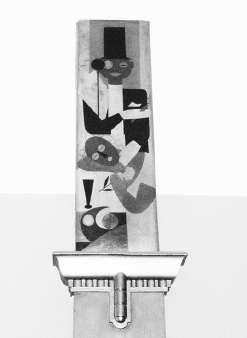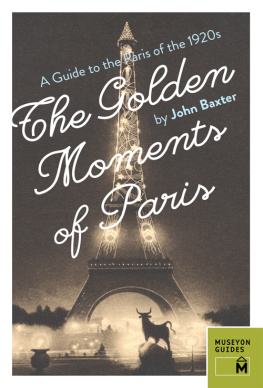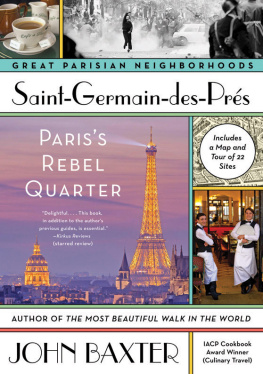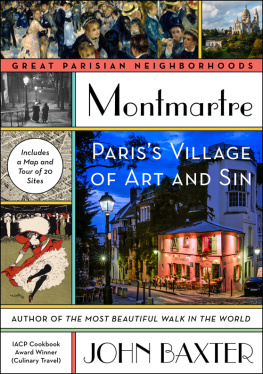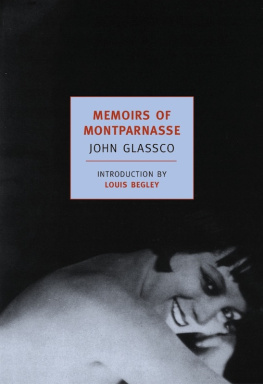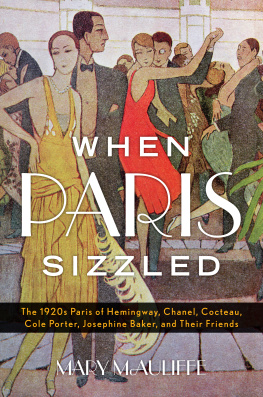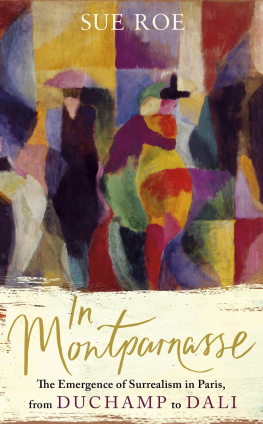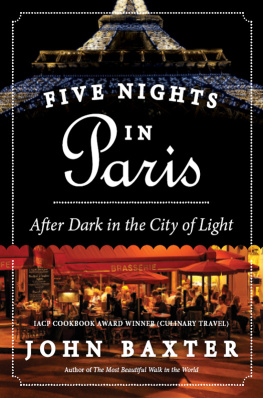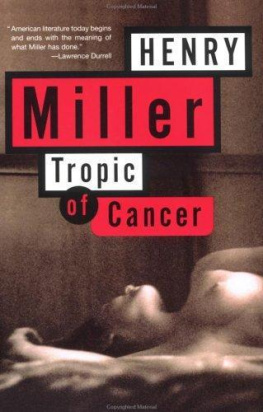For my French family, who took me in.
What gift could be greater than that?
From the shores
of oval oceans
in the oxidized Orient
Onyx-eyed Odalisques
and ornithologists
observe
the flight
of Eros obsolete
And Immortality
mildews...
in the museums of the moon.
Mina Loy, from Lunar Baedeker, 1923
CONTENTS
Guide
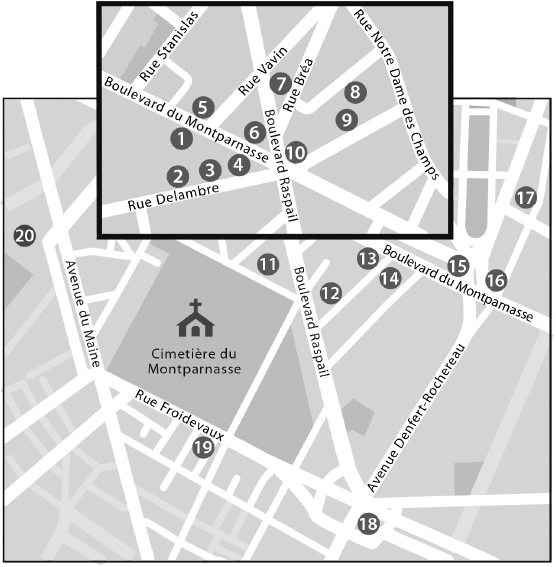
Map by Tony Foster
Montparnasse

La Coupole
Dingo Bar
At the Sign of the Black Manikin
Cafe du Ddme
Le Select
La Rotonde
Cafe Charivari
Academie Carmen
Academie Colarossi
Model Market
Le Sphinx
Man Ray Home
Le Jockey
Cafe Rosalie & the Cite des Artistes
Closerie des Lilas and Ney Statue
Bal Bullier
Man Ray Studio
Catacombs and Ledoux Customs Houses and La Californie
Hemingway Studio, 69 rue Froidevaux
Gare Montparnasse
We have lingered in the chambers of the sea By sea-girls wreathed with seaweed red and brown Till human voices wake us, and we drown.
T. S. ELIOT, FROM THE LOVE SONG OF J. ALFRED PRUFROCK
O N WINTER MORNINGS, THE CAFS OF MONTPARNASSE exude a chill, like sea caves at low tide.
Waiting for the rain to ease and dawdling over a caf crme already gone cold, I enjoyed the faintly echoing emptiness of the largest of them, La Coupole.
A lone waiter glided by, glanced at my cup, and, fishlike, idled away among the square pillars that, as precisely as the measures of an alexandrine, parse the lofty space under the cupola that gives the caf its name. From the kitchen, a distant clank hinted at food in preparation, but not much, and not soon.
At the grand opening of La Coupole on December 20, 1927, 2,500 guests affirmed a Montparnasse tradition by draining 1,200 bottles of champagne. Unless you count the Folies Bergres newest star, Josephine Baker, few Americans were present, a situation decisively reversed in the decade that followed. Every liner from New York brought hordes of new arrivals flooding into La Coupole. Those who didnt find seats at the mirrored cocktail bar took tables in one of its two restaurants, or headed downstairs to its dance hall, perhaps also visiting the marbled art deco restrooms, amenities so chic it still feels vulgar to do anything more physical there than wash ones hands.
Its slick decor gives no hint that La Coupole started life as a coal and firewood depot, a not uncommon genesis for Paris cafs, some of which developed from impromptu canteens where haulers took a break and a hot drink between deliveries. In 1926, the Juglar yard at 102 Boulevard du Montparnasse came on the market just as Ernest Fraux and his brother-in-law Ren Lafon resigned as managers of the nearby Caf du Dme.
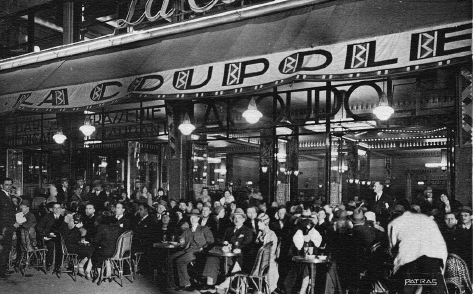
La Coupole in the 1920s.
Swelling numbers of American tourists had convinced them there was room for a caf built with foreigners in mind. Buying the coal yard cheap, they constructed an entertainment center providing food, drink, and diversion eighteen hours a day. Locals shunned this giant cabaret on the German model but Americans were enthusiastic. Arriving mid-afternoon for the daily tea dance, they could share martinis and cosmopolitans with friends at the cocktail hour, enjoy a long dinner, then tango or fox-trot into the early hours.
As oblivious to what went on outside as they had been on the Cunard or White Star liners that carried them across the Atlantic, clients of the Coupole were often startled, emerging at four in the morning in search of a cab, to find, standing by the door, the same pale girl with her tray of posies and toys whod been there when they entered twelve hours before. Beyond her shuffled the sleepless parade of panhandlers and prostitutes, street musicians, jugglers, miscellaneous bohemians, and practitioners of the three-card trick who cruised the boulevard from dusk to dawn.
Some visitors looked away, embarrassed by this display of shabbiness and need. Others sensed in its presence an implied rebuke. Scott Fitzgerald, his way barred by a street vendor not unlike the girl at La Coupole, sent her tray flying. Another tourist, noticing for the first time the handful of notes and coins hed been given in change, scattered it impulsively on the sidewalk among the smeared spit and cigarette butts. Theres your cheap franc, he murmured to a companion as men and women scrambled for the money. Not worth the trouble of putting it in your pocket.
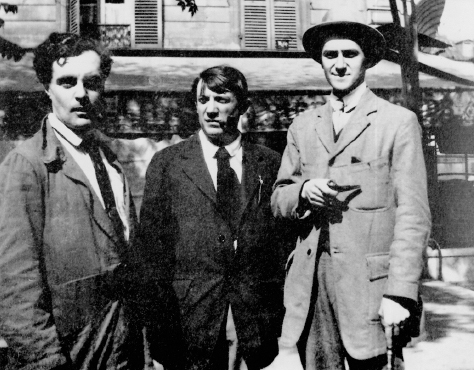
Amedeo Modigliani, Pablo Picasso, and Andr Salmon, 1916.
THE PILLARS OF LA COUPOLE
As La Coupole neared completion in 1927, the management asked art experts Charles Dufresne, Florent Fels, and Andr Salmon to propose painters to decorate its sixteen pillars and seventeen half pillars or pilasters.
Officially, they chose artists faithful to the bohemian spirit of Montparnasse, but for Salmon to have approached, for example, his good friend Pablo Picasso would have been insulting. Most of those selected were relative unknowns, dismissed, unkindly, by one critic as Russians, Poles, and Danubians [who] reflect the nature of Montparnasse in general as a refuge for exiles and outlaws. Between twenty-eight and thirty artists were involved. (Two pilasters cant be attributed, three or four other attributions are speculative, and two damaged columns were repainted during renovations in 1987.) It was long believed the management paid for the work in free meals, but, from accounts discovered in 1993, we now know that some shrewd accountant, estimating the cost of providing thirty hungry painters with dinners in perpetuity, opted for payment in cash. He allocated FF23,000: about $25,000 today. Given these modest rates, its not surprising only a few paintings rise above the decorative. They include the most frequently reproduced image, of an African in a top hat and monocle with his date passed out in his lap. Sometimes misattributed to Fernand Lger, its actually by Marie Vassilieff, best known for her dolls and marionettes. Jules Pascin can be seen on another column, seated, in his trademark bowler hat. Victor Robiquet immortalized Josephine Baker, plumed in ostrich feathers, and Vassilieff showed writer George Duhamel playing the flute, as hed done to amuse himself in the trenches of the Somme. (Id have preferred a piano, he said, but I couldnt get one into my pack.)
In almost a century, La Coupole has undergone many changes. The dance hall survives, but at the expense of the first-floor restaurant and a rooftop terrace where the rowdier elements of Montparnasse sometimes played bicycle polo. Both were absorbed into the additional levels of office space added by the current owners. However, the 600-seat brasserie, now designated a national monument, remains, along with its pillars, mostly intact.
